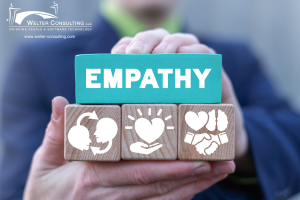
Empathy mapping is a new term—and a new approach—to understanding people’s experiences. The purpose is to understand the perceptions and experiences of a particular group so well that you can think, feel, and completely empathize with them, knowing them so well that it is like knowing yourself. By undergoing an empathy mapping exercise, you’ll be able to immerse yourself in the thoughts, feelings, and experiences of a discrete group and thus empathize with them better.
Market researchers have used empathy mapping to understand target audiences for the sole purpose of improving their marketing messages. Now, the concept of empathy mapping is spreading to leadership development as well as other endeavors to build trust, understanding, and alignment among different communities.
If the concept intrigues you, here’s how you can make a start at empathy mapping and, by doing so, better understand what your constituents may need. The results can be applied to improving programs, services, and other deliverables to those served by your nonprofit.
What Is Empathy Mapping?
Empathy mapping is a tool that asks pertinent questions about a discrete group of people. By answering these questions, one gains insight into the group’s thoughts, feelings, motivations, desires, and needs. This, in turn, can fuel improved programs and services for a nonprofit, as well as help improve marketing communications and messaging to the target group. When you truly understand what people feel or desire and what motivates them, you can tap into it with powerful messages.
The Empathy Mapping Process
To engage in the empathy mapping process, first identify the target group. It must be clearly defined. Do not put two or more groups of people together even if you believe they are similar; look at each group separately. For example, an education nonprofit dedicated to helping students get to college may wish to map each school grade as a separate cohort. Starting with high school seniors, they can empathy map seniors (1), juniors (2), sophomores (3), freshmen (4), and so on, down to whatever grade level they deem appropriate, to better understand the motivations, thoughts, needs and desires of each group.
Empathy mapping focuses on four key questions:
- Perception: How does this group perceive the world around them?
- Action: How do they interact with the world around them?
- Feeling: How do they feel? What emotions are they experiencing?
- Needs: What are their wants, needs, and goals?
Answers to these questions are then written down in a so-called map, which then forms a picture of the group as a whole. If the answers aren’t known or easily extrapolated, they can be asked of the group.
Group Exercise
Empathy mapping can often be more effective when done as a group exercise. The combined knowledge, experience, and insights from a group offers more depth to the final empathy map.
To perform the exercise in a group, gather together in a conference room and divide a whiteboard into four sections with the headings Perception, Action, Feeling, and Needs. Pass around pens and sticky notes. Ask people to participate by asking the question then having them answer on the sticky note. They can then affix the note to each column. At the end of the exercise, work as a group to write up the statements summarizing the feedback. The emerging picture may surprise you with its clarity and fully fleshed out picture of the target group.
Empathy Mapping Application Methods
Once you’ve created an empathy map, the next step is to use it to refine and enhance your program areas and marketing messages.
- Use the information about wants, needs, and feelings to fine-tune your programs and services to the target markets’ needs
- Refine messaging and communication to address fears
- Restate perceptions and offer alternatives
Everyone wants to feel heard and respected. By using empathy mapping, you’re moving in the right direction to help constituents feel you understand them in a meaningful way.
Welter Consulting
Welter Consulting bridges people and technology together for effective solutions for nonprofit organizations. We offer software and services that can help you with your accounting needs. Please contact Welter Consulting at 206-605-3113 for more information.




Recent Comments